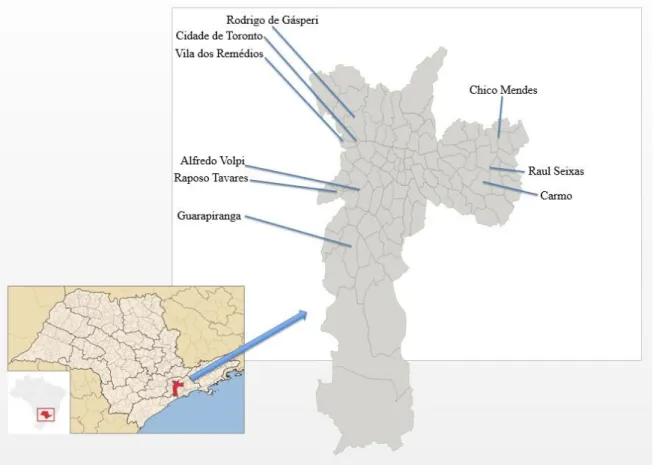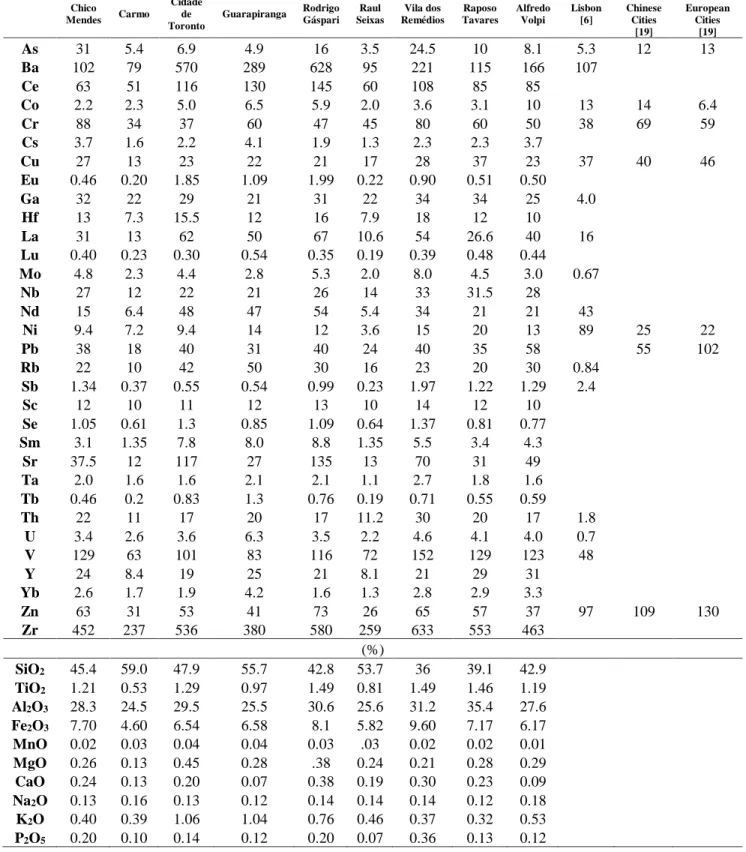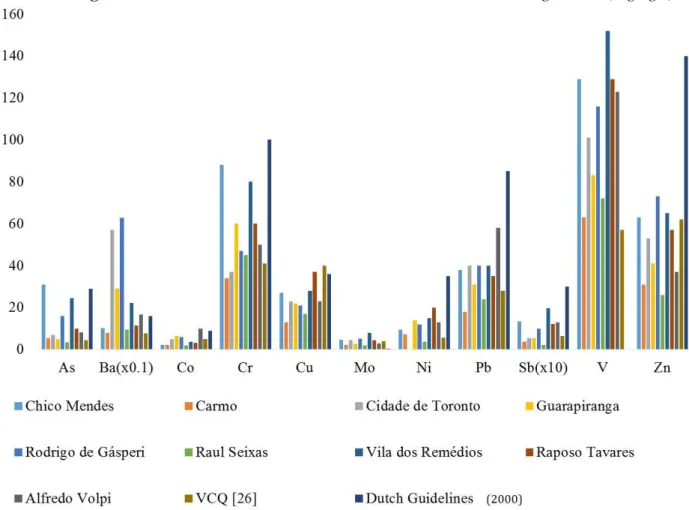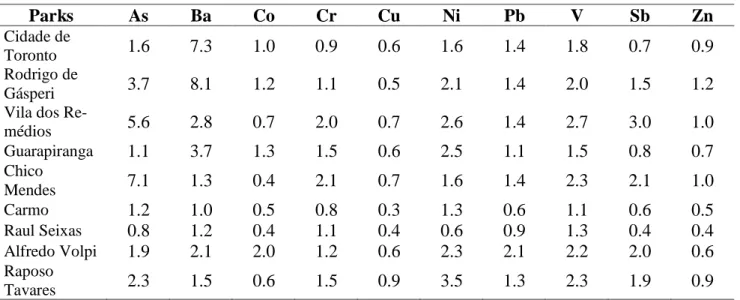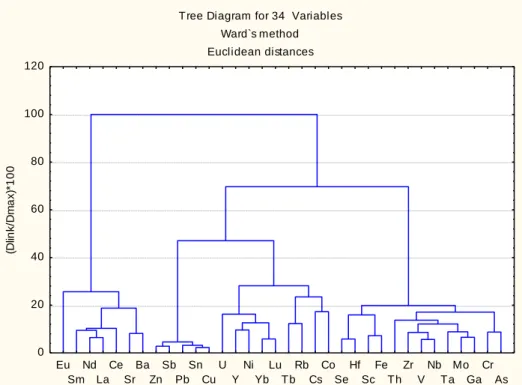BJRS
RADIATION SCIENCES
07-02A (2019) 01-13ISSN: 2319-0612
Accept Submission: 2018-12-03
Chemical characterization of urban park soils of the
metropolitan region of São Paulo
Figueiredo
aA. M. G., Enzweiler
bJ., Lange
aC. N., Sígolo
cJ.B.
aInstituto de Pesquisas Energéticas e Nucleares (IPEN / CNEN – SP), 05508-000, São Paulo, SP, Brazil b Instituto de Geociências da Universidade Estadual de Campinas – UNICAMP, 13083-870, Campinas, SP, Brazil
c Instituto de Geociências da Universidade de São Paulo – USP, 05508-080, São Paulo, SP, Brazil
anamaria@ipen.br
ABSTRACT
In the last years, urban soils have been increasingly subject of investigations concerning their description and composition. In several important cities all over the world, urban soils show a significant increase in metal levels, due to the rise of pollution originated from continuous urbanization and industrial development. This metal contamination can disturb the natural geochemical cycles and their depending ecosystems. The expected popula-tion growth during the next decades will concentrate in urban areas, which are already the predominant human habitat. Metal contamination is a key issue in São Paulo City, the biggest urban agglomeration in Latin Ameri-ca. There has been little research on metal levels in São Paulo urban soils and almost nothing related to the city’s parks. The present study presents the concentration of major and trace elements in soil samples of nine parks of the metropolitan region of São Paulo. Topsoil samples (0-20 cm) were collected in lines across the parks in order to have representative samples of the entire park. Instrumental Neutron Activation Analysis (INAA) and X-ray Fluorescence (XRF) were used for whole elemental analysis. The outcome of this study showed that the soils of the public parks studied presented, in general, concentration levels higher than the reference values for soils in São Paulo State. For As, V and Ni, which showed significant enrichment factors in relation to reference values, there is an indication of anthropogenic source. Cluster analysis grouped the elements Zn, Sb, Pb and Cu, well known as traffic-related elements, which may indicate a vehicular source.
1. INTRODUCTION
In the last years, urban soils have been increasingly subject of investigations that include their chemical characterization. As a result, a significant increase in metal levels in urban soils as com-pared to non urban soils was observed in cities such as Madrid [1], Palermo [2], Naples [3], Hong Kong [4], Torino [5], Lisbon [6], and many others, due to the rise of metal pollution originating from continuous traffic and industrial related sources. Ajmone-Marsan and Biasoli [7] reviewed 153 studies published during a recent period of 10 years, in which the urban environment was assessed and trace elements in soils of 94 world cities were investigated. According to those authors, the high data variability among the studies derives from the variety of land uses, number of samples, the depth of sample collection and also sample treatments and analytical methods.
The distribution of trace elements in soils is controlled by biogeochemical processes related to parameters such as metal solubility and physicochemical characteristics of the soil, especially for non-disturbed soils. Natural and non-disturbed soils mostly allow water percolation, which may transport trace metals through the soil profile, either as dissolved species or sorbed to fine particles, which eventually may be trapped by soil components. In urban soils, however, surface runoff is the main water flow mechanism because percolation is significantly reduced by impervious surfaces. In principle, any extra metal input can disturb the natural biogeochemical cycle of ecosystems [8], specialty because several activities affect soils in urban areas. Therefore, it is expected that the abil-ity of the terrestrial environment of fixing or immobilizing contaminant metals is limited in compar-ison to the natural environment [9].
The expected population growth during the next decades will take place in urban areas, with al-most no growth in the rural population [9]. It is estimated that by the year 2050 about 70% of the global population will live in cities. Thus, the urban environment will become the predominant hu-man habitat.
Metals are not biodegradable and accumulate in nature. The prolonged presence of the contami-nants in the urban environment, particularly in urban soils, and the proximity to city inhabitants can cause harmful exposure to metals through inhalation, ingestion, and dermal [10-13]. Children,
obvi-ously, are more susceptible to the adverse effects of soil ingestion or inhalation than adults because their nervous system is under development and higher absorption rate [2, 13].
Metal contamination is an important environmental issue in São Paulo City, the biggest city in Latin America, but there is almost nothing related to the city’s parks. A study concerning metal levels in São Paulo urban soils [14] and data from topsoil samples (0-5 cm) from seven urban parks of São Paulo [15] have already been reported.
São Paulo city has suffered a rapid and disordered growth in the last decades, which has led to considerable loss in agricultural soils and urban green spaces. Therefore, São Paulo public parks play an important role as leisure areas for the population, mainly for children. The present study presents the concentration of major and trace elements in soil samples of nine parks of the metro-politan region of São Paulo.
2. MATERIALS AND METHODS
The Metropolitan region of São Paulo, RMSP, is located at 23o S and 46o W in the southeastern region of Brazil. It covers an area of 8,051 km2, with about 21 million inhabitants. The RMSP oc-cupies about 0.1% of the Brazilian territory and is the third largest urban conglomerate in the world, responsible for 1/6 of the gross national product [16]. According to CETESB, the Environmental Protection Agency of the State of São Paulo, the RMSP suffers from all kinds of environmental problems. The main contributions to atmospheric emissions come from about 2,000 highly pollut-ing industries and an ever increaspollut-ing 7 million vehicle fleet [17]. Nine public parks of São Paulo, covering different regions of the city, were studied (Fig. 1).
2.2. Sampling Strategy
The soil samples were collected between October 2006 and April 2007. Topsoil samples (0–20 cm) were collected in lines across the park every 30 m, providing 10-15 samples of about 500 g each in each park. Sampling aimed to represent the most of each park area, mainly covering sites where the flux of people is more intense, such as jogging paths, sport and leisure areas. A polyeth-ylene tube with 4 cm diameter was used to take the samples, which were stored in inert plastic bags.
In the laboratory, the samples were dried at 40oC and sieved through plastic-only sieves, to separate the < 2 mm fractions. Before and after sieving, the samples were homogenized and quartered. The samples were ground using an agate mortar in order to obtain a fine and homogeneous powder (< 75 μm).
Figure 1: Localization of the studied parks in São Paulo city.
2.3. Soil Properties
The soil samples contained 40 to 88% of clay-silt particles (< 0.063 mm). The amount of fine grain size is characteristic of samples from the eastern area of the city. The pH values of the soil samples ranged from 3.3 to 6.8, but most of the values were around 4.5-5.0, indicating acid soils. The content of total organic carbon in the soil ranged between 1.2 to 8.3%.
Instrumental Neutron Activation Analysis (INAA) and X-ray Fluorescence (XRF) were used for whole elemental analysis. Instrumental neutron activation analysis (INAA) was employed to ana-lyse the elements As, Ba, Co, Cr, Sb and Zn, as well as Cs, Fe, Hf, Rb, Sc, Ta, Th, U and the lan-thanides (La, Ce, Nd, Sm, Tb, Yb and Lu). One hundred to one hundred and fifty mg of each sam-ple and of the geological reference materials basalt BE-N (ANRT), granite GS-N (ANRT) and, for quality control, SOIL-7 (IAEA), were accurately weighed in polyethylene bags. Samples and refer-ence materials were irradiated for 8 hours at a thermal neutron flux of 1013 n cm-2 s-1 at the IEA-R1 nuclear reactor of IPEN.
The measurements of the induced gamma-ray activity were carried out using a gamma-ray spec-trometer with a GX20190 hyperpure Ge detector (Canberra). The analysis of the certified reference material Soil-7 (IAEA) provided measurement bias (< 5%) and coefficients of variation (< 15%). X-ray florescence spectrometry (XRF) was employed to determine Cu, Ga, Ni, Nb, Mo, Se, Sn, Sr, Pb, V, Zr, Y and the oxides Al2O3, Fe2O3, MnO, MgO and CaO, among others. Pellets (40 mm
di-ameter) consisting of a mixture of 9 g of the sample and 1.5 g of powdered wax (Hoechst) were prepared and measured using a WD-XRF spectrometer (PW2404, Philips) [18]. The accuracy and precision of the results were verified by the analysis of the reference materials GSS-2 and GSS-4 (soil, Institute of Geophysical and Geochemical Exploration, China). Measurement bias and coeffi-cients of variation were better than 10%.
3. RESULTS AND DISCUSSION
The results obtained are presented in Table I. Most of the studies on urban soils are focused in the potentially toxic elements As, Co, Cr, Cu, Ni, Pb and Zn, and there is not much information about other trace elements, such as rare earth elements, U and Th. The data are a contribution to the knowledge of the concentration of trace and major elements in urban park soils of São Paulo, since there is still little information on São Paulo urban soils composition. For comparison, some litera-ture data are presented in Table I. Several studies on trace metals in urban soils have been reported for many other cities in the world, the majority of them in the soils of European cities, where the main sources of pollution have been from industry and/or traffic emissions. Table I presents, for
comparison, the results of the average of trace metals of 34 European cities [19], more recent results from Lisbon [6] and the average values of 21 Chinese cities [19].
Considering the elements As, Co, Cr, Cu, Ni, Pb and Zn, in relation to Chinese and European soils, only As presented significant higher values, in Chico Mendes and Vila dos Remédios parks. There is little information on background concentrations of As in urban soils [20]. Kabata-Pendias and Pendias [21] report soil arsenic concentrations in undisturbed areas between 0.1 and 40 mg kg-1 worldwide, with an arithmetic mean concentration of 5 to 6 mg kg-1. Chirenje et al. [20] report As concentrations in Gainesville soils, in Florida, ranging from 0.21 to approximately 660 mg kg-1, and from 0.32 to 110 mg kg-1 in Miami soils, depending on the land-use classes (residential, commer-cial, and public land).
According to the EPA Preliminary Remediation Goals (PRGs) [22], As levels of 4.5 mg kg-1 may cause cancer risk of one per million through dermal absorption. A possible source of As is its use in fertilizers and pesticides. Chromated copper arsenate (CCA) treated wood is widely used in the fabrication of outdoor decks and playground equipment’s and is a source of arsenic contamina-tion for soils and groundwater [23]. Considering the trigger value for direct exposicontamina-tion for children soil parks (25 mg kg-1, according to the German Federal Legislation of Soil Protection [24]), it can
be noticed that the As concentration in Chico Mendes park requires a further investigation to identi-fy if there is indeed danger or contamination. Antimony and V are considered traffic related ele-ments, and these results suggest that fuel combustion may be a source of this element in the soils. In relation to Lisbon soils, Sc, Th, U, Ga and La presented higher values. These elements are not usually related to anthropogenic sources, and the results may be may be attributed to the lithology of São Paulo.
Table I: Mean Values of Topsoil Metal Concentration in Public Parks of São Paulo and Literature Values (mg kg-1). Chico Mendes Carmo Cidade de Toronto Guarapiranga Rodrigo Gáspari Raul Seixas Vila dos Remédios Raposo Tavares Alfredo Volpi Lisbon [6] 21 Chinese Cities [19] 34 European Cities [19] As 31 5.4 6.9 4.9 16 3.5 24.5 10 8.1 5.3 12 13 Ba 102 79 570 289 628 95 221 115 166 107 Ce 63 51 116 130 145 60 108 85 85 Co 2.2 2.3 5.0 6.5 5.9 2.0 3.6 3.1 10 13 14 6.4 Cr 88 34 37 60 47 45 80 60 50 38 69 59 Cs 3.7 1.6 2.2 4.1 1.9 1.3 2.3 2.3 3.7 Cu 27 13 23 22 21 17 28 37 23 37 40 46 Eu 0.46 0.20 1.85 1.09 1.99 0.22 0.90 0.51 0.50 Ga 32 22 29 21 31 22 34 34 25 4.0 Hf 13 7.3 15.5 12 16 7.9 18 12 10 La 31 13 62 50 67 10.6 54 26.6 40 16 Lu 0.40 0.23 0.30 0.54 0.35 0.19 0.39 0.48 0.44 Mo 4.8 2.3 4.4 2.8 5.3 2.0 8.0 4.5 3.0 0.67 Nb 27 12 22 21 26 14 33 31.5 28 Nd 15 6.4 48 47 54 5.4 34 21 21 43 Ni 9.4 7.2 9.4 14 12 3.6 15 20 13 89 25 22 Pb 38 18 40 31 40 24 40 35 58 55 102 Rb 22 10 42 50 30 16 23 20 30 0.84 Sb 1.34 0.37 0.55 0.54 0.99 0.23 1.97 1.22 1.29 2.4 Sc 12 10 11 12 13 10 14 12 10 Se 1.05 0.61 1.3 0.85 1.09 0.64 1.37 0.81 0.77 Sm 3.1 1.35 7.8 8.0 8.8 1.35 5.5 3.4 4.3 Sr 37.5 12 117 27 135 13 70 31 49 Ta 2.0 1.6 1.6 2.1 2.1 1.1 2.7 1.8 1.6 Tb 0.46 0.2 0.83 1.3 0.76 0.19 0.71 0.55 0.59 Th 22 11 17 20 17 11.2 30 20 17 1.8 U 3.4 2.6 3.6 6.3 3.5 2.2 4.6 4.1 4.0 0.7 V 129 63 101 83 116 72 152 129 123 48 Y 24 8.4 19 25 21 8.1 21 29 31 Yb 2.6 1.7 1.9 4.2 1.6 1.3 2.8 2.9 3.3 Zn 63 31 53 41 73 26 65 57 37 97 109 130 Zr 452 237 536 380 580 259 633 553 463 (%) SiO2 45.4 59.0 47.9 55.7 42.8 53.7 36 39.1 42.9 TiO2 1.21 0.53 1.29 0.97 1.49 0.81 1.49 1.46 1.19 Al2O3 28.3 24.5 29.5 25.5 30.6 25.6 31.2 35.4 27.6 Fe2O3 7.70 4.60 6.54 6.58 8.1 5.82 9.60 7.17 6.17 MnO 0.02 0.03 0.04 0.04 0.03 .03 0.02 0.02 0.01 MgO 0.26 0.13 0.45 0.28 .38 0.24 0.21 0.28 0.29 CaO 0.24 0.13 0.20 0.07 0.38 0.19 0.30 0.23 0.09 Na2O 0.13 0.16 0.13 0.12 0.14 0.14 0.14 0.12 0.18 K2O 0.40 0.39 1.06 1.04 0.76 0.46 0.37 0.32 0.53 P2O5 0.20 0.10 0.14 0.12 0.20 0.07 0.36 0.13 0.12
Fig. 2 presents the results obtained for the potentially toxic elements As, Ba, Co, Cr, Cu, Mo, Ni, Pb, V and Zn and the Quality Condition Values (VCQ) in soils of the metropolitan region of São Paulo, according to the governmental environmental agency of the state of São Paulo, CETESB [25].
Figure 2: Trace Elements in São Paulo Public Parks and Guiding Values (mg kg-1).
These values were defined based on the assessment of the characteristics of São Paulo state soils at almost pristine sites, i.e., without significant impacts of anthropogenic activities, and can be con-sidered as background values. The results were also compared with the Netherlands Soil Contami-nation Guidelines, commonly referred to as the Dutch Soil Standard [26], often used as a standard in similar studies [27]. Soils with concentration levels below the Dutch target values are considered of sustainable quality. This means that soils are relatively unpolluted. According to the Dutch Soil Standard, concentrations exceeding the target value suggest that the soils may be contaminated.
It can be observed that As, Ba, Ni, Sb and V presented concentration levels higher than VCQ values in most parks, except As and Ni in Raul Seixas park, showing a significant increase com-pared to non urban soils. Cu presented concentration values below VCQ in all parks and Cr in Chi-co Mendes and Vila dos Remédios parks. Zn was higher than VCQ in Rodrigo de Gásperi and Vila dos Remédios parks.
In comparison to the Dutch guiding values, in general, all the studied elements presented con-centration levels below the target values, except As in Chico Mendes park and Ba in Cidade de To-ronto and Rodrigo de Gásperi parks. According to the Dutch Soil Standards, most of the parks are considered not polluted for the studied elements, except Chico Mendes park for As and Cidade de Toronto, Guarapiranga, Rodrigo de Gásperi and Vila dos Remédios parks, for Ba. The high results obtained for Ba in Rodrigo de Gásperi and Vila dos Remédios parks may be attributed to the lithol-ogy of these parks (granites, gneisses and migmatites), indicating a crustal origin of Ba.
The enrichment factors were also calculated considering as geochemical background the Quality Condition Value (VCQ) [25]. Therefore, EF is the mean concentration of the element in the park in relation to VCQ in the metropolitan region of São Paulo (Table II).
Table II: Enrichment Factors in relation to VCQ values.
Parks As Ba Co Cr Cu Ni Pb V Sb Zn
Cidade de
Toronto 1.6 7.3 1.0 0.9 0.6 1.6 1.4 1.8 0.7 0.9
Rodrigo de
Gásperi 3.7 8.1 1.2 1.1 0.5 2.1 1.4 2.0 1.5 1.2
Vila dos
Re-médios 5.6 2.8 0.7 2.0 0.7 2.6 1.4 2.7 3.0 1.0 Guarapiranga 1.1 3.7 1.3 1.5 0.6 2.5 1.1 1.5 0.8 0.7 Chico Mendes 7.1 1.3 0.4 2.1 0.7 1.6 1.4 2.3 2.1 1.0 Carmo 1.2 1.0 0.5 0.8 0.3 1.3 0.6 1.1 0.6 0.5 Raul Seixas 0.8 1.2 0.4 1.1 0.4 0.6 0.9 1.3 0.4 0.4 Alfredo Volpi 1.9 2.1 2.0 1.2 0.6 2.3 2.1 2.2 2.0 0.6 Raposo Tavares 2.3 1.5 0.6 1.5 0.9 3.5 1.3 2.3 1.9 0.9
The EFs were in general lower than 1 for Cu and Zn, indicating a natural source for these ele-ments in the studied soils. Co, Cr, Pb and Sb presented similar EFs in most the park soils (except Sb in Vila dos Remédios), showing an enrichment to clean soils but no indication of its origin. Ba
pre-sented EFs of about 1 only in Carmo, Raul Seixas, Chico Mendes and Raposo Tavares parks. Nev-ertheless, the high Ba concentrations may be natural, due to the composition of the lithology of the region. In the case of As, V and Ni, which showed significant EFs in most parks, there is an indica-tion of anthropogenic source.
The hierarchical dendrogram obtained by cluster analysis is shown in Fig. 3, where two main groups can be identified. The first group is integrated by the rare earth elements Sr and Ba, indicat-ing geogenic origin. The second group can be divided in two main sub-clusters, which are devided in sub-groups. It is remarkable that the traffic related elements Zn, Sb, Cu, Pb and Sn are included in one sub-group, what may indicate vehicular source. The other sub-groups include the elements U, Y, Ni, Yb and Lu; Tb, Rb, Cs and Co, in one group and Se, Hf, Sc, Fe; Th, Zr, V, Nb, Ta, Mo, Ga; Cr and As in other group. The fact that As and Cr are separated from the other elements indi-cate a common source, which may be the chromated copper arsenate (CCA) treated wood used in playground equipment’s.
Figure 3: Cluster Analysis.
Tree Diagram for 34 Variables Ward`s method Euclidean distances Eu Sm Nd La Ce Sr Ba Zn Sb Pb Sn Cu U Y Ni Yb Lu Tb Rb Cs Co Se Hf Sc Fe Th Zr V Nb Ta Mo Ga Cr As 0 20 40 60 80 100 120 (D lin k/ D m a x) *1 0 0
4. CONCLUSION
The results obtained showed that the soils of the nine São Paulo public parks studied presented, in general, concentration levels higher than the reference values for soils in São Paulo State. In comparison to the Dutch guiding values, in general, all the studied elements presented concentration levels below the target values. Arsenic presented higher levels in comparison to background levels and, in Chico Mendes park, higher than the target values of the Dutch standards, which corroborates to suggest an anthropogenic source. Cluster analysis showed the presence of Zn, Sb, Pb and Cu, well known as traffic-related elements, in a separate group, which may indicate a vehicular source.
ACKNOWLEDGMENT
The authors thank Fundação de Amparo à Pesquisa do Estado de São Paulo and Conselho Naci-onal de Desenvolvimento Científico e Tecnológico for financial support.
REFERENCES
1. DE MIGUEL, E.; JIMÉNEZ DE GRADO, M.; LLAMAS, J.F.; MARTÍN-DORADO, A; MAZADIEGO, L.F. The overlooked contribution of compost application to the trace ele-ment load in the urban soil of Madrid (Spain). Sci Total Environ, v. 215, p. 113-122, 1998. 2. MANTA, D.S.; ANGELONE, M.; BELLANCA, A.; NERI, R.; SPROVIERI, M. Heavy
metals in urban soils: a case study from the city of Palermo (Sicily), Italy. Sci Total
Envi-ron, 300, p. 229-243, 2002.
3. IMPERATO, M.; ADAMO, P.; ARIENZO, M.; STANZIONE, D.; VIOLANTE, P. Spatial distribution of heavy metals in urban soils of Naples city (Italy). Eviron Pollut, 124, p. 247-256, 2003.
4. LEE, C.S.; LI, X.; SHI, W.; CHEUNG, S.C.; THORNTON, L. Metal contamination in ur-ban, suburur-ban, and country park soils of Hong Kong: A study based on GIS and multivariate statistics. Sci Total Environ, v.356, p.45-61, 2006.
5. SIALELLI, J.; DAVIDSON, C.M.; HURSTHOUSE, A.S.; AJMONE-MARSAN, F. Human bioaccessibility of Cr, Cu, Ni, Pb and Zn in urban soils from the city of Torino, Italy.
6. CACHADA, A.; DIAS, A.C.; PATO, P.; MIEIRO, C.; ROCHA-SANTOS, T.; PEREIRA, M.E.; FERREIRA DA SILVA, E.; DUARTE, A.C. Major inputs and mobility of potentially toxic elements contamination in urban areas. Environ Monit Assess, v.185, p. 279-294, 2012.
7. AJMONE-MARSAN, F.; BIASIOLI, M. Trace Elements in Soils of Urban Areas. Water
Air Soil Pollut, v.213, p.121–143, 2010.
8. LEE, C.S.; LI, X.; SHI, W.; CHEUNG, S.C.; THORNTON, L. Metal contamination in ur-ban, suburur-ban, and country park soils of Hong Kong: A study based on GIS and multivariate statistics. Sci Total Environ, v.356, p. 45-61, 2006.
9. WONG, C.S.C.; LI, X.D.; THORNTON, I. Urban environmental geochemistry of trace met-als. Environ Pollut, v.142, p.1-16, 2006.
10. MIELKE, H.W.; REAGAN, P.L. Soil is an important pathway of human lead exposure.
En-vironmental Health Perspectives, v.106, p. 217–229, 1998.
11. MIELKE, H.W.; SMITH, M.K.; GONZALES, C.R.; MIELKE, P.W. The urban environment and children’s health: soils as an integrator of lead, zinc and cadmium in New Orleans, Lou-isiana, U.S.A. Environmental Research, v.80, p. 117–129, 1999.
12. ABRAHAMS, P.W. Soils: their implications to human health. Sci Total Environ, v.291, p. 1-32, 2002.
13. LJUNG, K.; SELINUS, O.; OTABBONG, E. Metals in soils of children’s urban environ-ments in the small northern European city of Uppsala. Sci Total Environ, v.366, p.749-759, 2006.
14. RIBEIRO, A.P.; FIGUEIREDO, A.M.G.; TICIANELLI, R.B.; NAMMOURA-NETO, G.M.; SILVA, N.C.; KAKAZU, M.H.; ZAHN, G. Metals and semi-metals in street soils of São Paulo city, Brazil. J Radioanal Nucl Chem, v.291, p. 137-142, 2012.
15. FIGUEIREDO, A.M.G.; ENZWEILER, J.; CAMARGO, S.P.; SÍGOLO, J.B.; GUMIERO, F.C.; PAVESE, A.C.; MILIAN, F.M. Metal contamination in urban park soils of São Paulo. J
Radioanal Nucl Chem, 280, p. 423-429, 2009.
16. CETESB, Relatório de qualidade do ar no Estado de São Paulo 2003 - São Paulo: CE-TESB, 2004. (Série Relatórios/ Secretaria de Estado do Meio Ambiente, ISSN 0103-4103). 17. IBGE, 2016. Instituto Brasileiro de Geografia e Estatística (Brazilian Institute of
Geo-graphy and Statistics). Cidades. Available from:
18. ZAMBELLO, F.R.; ENZWEILER, J. Multi-element analysis of soils and sediments by wavelength-dispersive X-ray fluorescence spectrometry. J Soils Sediments, v.2, p. 29-36, 2002.
19. LUO, X.S.; YU, S.; ZHU, Y.G.; LI, X.D. Trace metal contamination in urban soils of China.
Sci Total Environ, v.421-422, p. 17-30, 2012.
20. CHIRENJE, T.; MA, L.Q.; SZULCZEWSKI, M.; LITTELL, R.; PORTIER, K.M.; ZIL-LIOUX, E. Arsenic Distribution in Florida Urban Soils: Comparison between Gainesville and Miami. J Environ Qual, v.32, p.109–119, 2003.
21. KABATA-PENDIAS, A.; PENDIAS, H. Trace elements in soils. Department at the Univer-sity of Florida, Dr. Helena Solo- and plants. CRC Press, Boca Raton, FL,1992.
22. ENVIRONMENTAL PROTECTION AGENCY, Users’ guide and background technical
document for USEPA region 9’s preliminary remediation goals (PRG) table, PRG 2004
Table. <http://www.epa.gov/region09/waste/sfund/prg/index.html> Last accessed: 21.07.17 23. HEMOND, H.F.; SOLO-GABRIELE, H.M. Children’s exposure to arsenic from
CCA-treated wooden decks and playground structures. Risk Analysis, v.24, p. 51-64, 2004. 24. CASARINI, S.C.P.; PINATTI, D.; LEMOS, L.C.; GAETA, M.M. Relatório de
estabeleci-mento de valores orientadores para solos e águas subterrâneas no Estado de São Paulo:
CETESB, São Paulo, 2001.
25. CETESB (São Paulo). Valores de condição da qualidade dos solos da bacia hidrográfica
do Alto Tietê – UGRHI 6 e região metropolitana de São Paulo – RMSP/CETESB; São
Paulo: CETESB, 70p., 2008 (Série Relatórios/CETESB, ISSN 0103403).
26. MINISTERIE VAN VOLKSHUISVESTING, RUIMTELIJKE ORDENING EN MILIEU-BEHEER. Circular on Target Values and Intervention Values for Soil Remediation. Cir-cular DBO/1999226863, Department of Soil Protection, Directorate-General for Environ-mental Protection, The Hague, 2000.
27. WONG, C.S.C.; Li X.D. Pb contamination and isotopic composition of urban soils in Hong Kong. Sci Total Environ, v.319, p.185-195, 2004.
